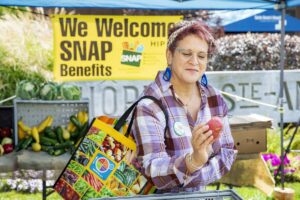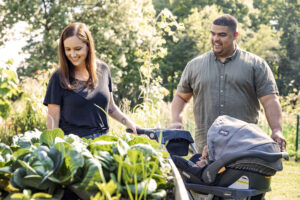This month Massachusetts SNAP-Ed is joining in on the celebration of National Nutrition Month. We will be having a series of blogs on a variety of topics including Eating a Variety of Nutritious Foods, Healthy Physical Activity Goals, Planning Your Meals and Snacks, and Tasty Food at Home. The kick-off week focuses on eating foods from each of the food groups, using the nutrition facts label, and making cultural meals while celebrating traditions. Some recent blogs touched upon these topics already, so this week we will chat about involving children in cultural meals and traditions. Food is a reason to gather, celebrate, and share. Celebrate the differences and similarities across race, ethnicity, gender, and culture. Nourish your family and fill them with pride in their culture as well as learn to appreciate others.
The Importance of Sharing Family Cultural Meals and Traditions
Cooking with your family is about making and enjoying food together. However, it goes deeper than that simple experience. Involving children in the preparation of a cultural meal will encourage:
- Cooking skills-measuring, peeling, cutting, baking, etc.
- Reading skills while using recipes handed down from generations past
- Cultural appreciation-talking with your child about why this dish was used every day or for holidays/special occasions
- Understanding unique characteristics of themselves that make them so special
- Adventurous eaters

Cooking with your children promotes conversations about their heritage and traditions that can be practiced at home. Especially, if extended family members live afar. Children can gain a sense of their heritage by spending time with an adult in the kitchen, asking questions, and learning customs and traditions tied to food. The same could be said if your family wants to learn about other cultures. Simply talking or reading about other cultures may not be enough to instill a sense of appreciation. If you “show” a particular heritage through cooking, your child will have something that makes the culture more real. They can touch, smell, see and taste the culture as you create a dish together.
Other ways of Learning About Cultures and Traditions
Take a journey through books, videos, or various websites; the opportunities are endless! Great discussions can be had with friends or neighbors regarding their ethnicity. Gather recipes to make with your own family. Take a trip to a food store specializing in ethnically diverse foods or try a new restaurant. Quite often your local store has a variety of different fruits and vegetables from various countries to try as a snack or in a special meal. Some examples include:
| FRUITS | COUNTRIES |
| Papaya | Central America |
| Jackfruit | Southeast Asia |
| Dragonfruit | Mexico/Latin America/Asia |
| Sour Plum | Middle East |
| Korean Melon | East Asia |

Jackfruit
| VEGETABLES | COUNTRIES |
| Romanesco Broccoli | Europe |
| Okinawan Purple Sweet Potato | East Asia |
| Jicama (turnip) | Mexico |
| Tomatillo (tomato) | Mexico |
| Kai Lan (Chinese Kale) | East Asia |

Romanesco
Celebrate Diversity
One of the best ways to help children appreciate another culture is to introduce it by means of a children’s book. Cooking and eating are something we all have in common and children can relate to them very easily. Books are great conversation starters for any topic, so why not food and culture? Here is a list of books for various ages:
- The Bagel King, by Andrew Larsen, 2018, for ages 3-7, Jewish
- Fry Bread-A Native American Family Story, by Kevin Noble Malliard, 2019, for ages 3-6, Native American
- Tomatoes for Neela, by Padma Lakshmi, 2021, for ages 3-7, Indian, with recipes
- My Food, Your Food, Our Food, by Emma Carlson Berne, 2019, for ages 4-7, with music
- Bee-Bim Bop, by Linda Sue Park, 2008, for ages 4-7, Korean, with the recipe
- Amy Wu and the Perfect Bao, Kat Zhang, 2019, for ages 4-8, Chinese, with the recipe
- Bilal Cooks Daal, by Aisha Saeed, 2019, for ages 4-8, Indian
- Cora Cooks Pancit, by Donna K. Lazo Gilmore, 2014, for ages 5-8, Filipino, with the recipe
- Gazpacho for Nacho, by Tracy Kyle, 2014, for ages 5-8, Spanish, with the recipe
- What’s On Your Plate: Exploring the World of Food, by Whitney Stewart, 2018, for ages 5-9, with many recipes
My Nonnie’s Risotto Recipe
As you may know, my name is Broc, short for broccoli. Broccoli is a native vegetable of Italy. My grandmother made risotto, or Italian rice, every Sunday for our family dinner. Making risotto immediately returns me to my youth and makes me feel like I am getting a big hug from my grandmother. Here is her easy-to-follow recipe:
Ingredients:
- 1 cup of rice
- 2 14.5 oz. of reduced-salt chicken broth
- 1 tablespoon of butter
- 1 small onion, diced
- 2 small carrots, diced
- ½ cup of Parmesan cheese
Directions:
- In one pot melt butter on medium heat, add rice and onion to brown.
- In another pot boil the broth and diced carrots for 5 minutes.
- Add a cup of broth to the rice pot.
- Allow the liquid to be absorbed.
- Continue to add a cup of a liquid, stir, and allow the absorption until the broth has been used. This should take at least 20 minutes.
- Check the softness of the rice, if it requires more broth, add following the same steps as above.
- When the rice is to your liking, add the parmesan cheese and stir until it is all combined.
- Add seasoning to your preference


Alternatives: peas and ham, mushrooms, Romano, or Asiago cheese.
Find additional cultural meal and recipe suggestions at https://www.eatright.org/food/resources/national-nutrition-month/toolkit. These pdf documents offer ways to personalize your plate to include foods from other cultures; available in Asian Indian, Chinese, Filipino, Latin America, and Middle Eastern. Embrace and celebrate a world of flavors with your family!
Ciao!-Broc




